A Guide to Flat Roof Maintenance in Arizona
By Sunrise Roofers LLC · Oct 21, 2025 · 16-24 min read
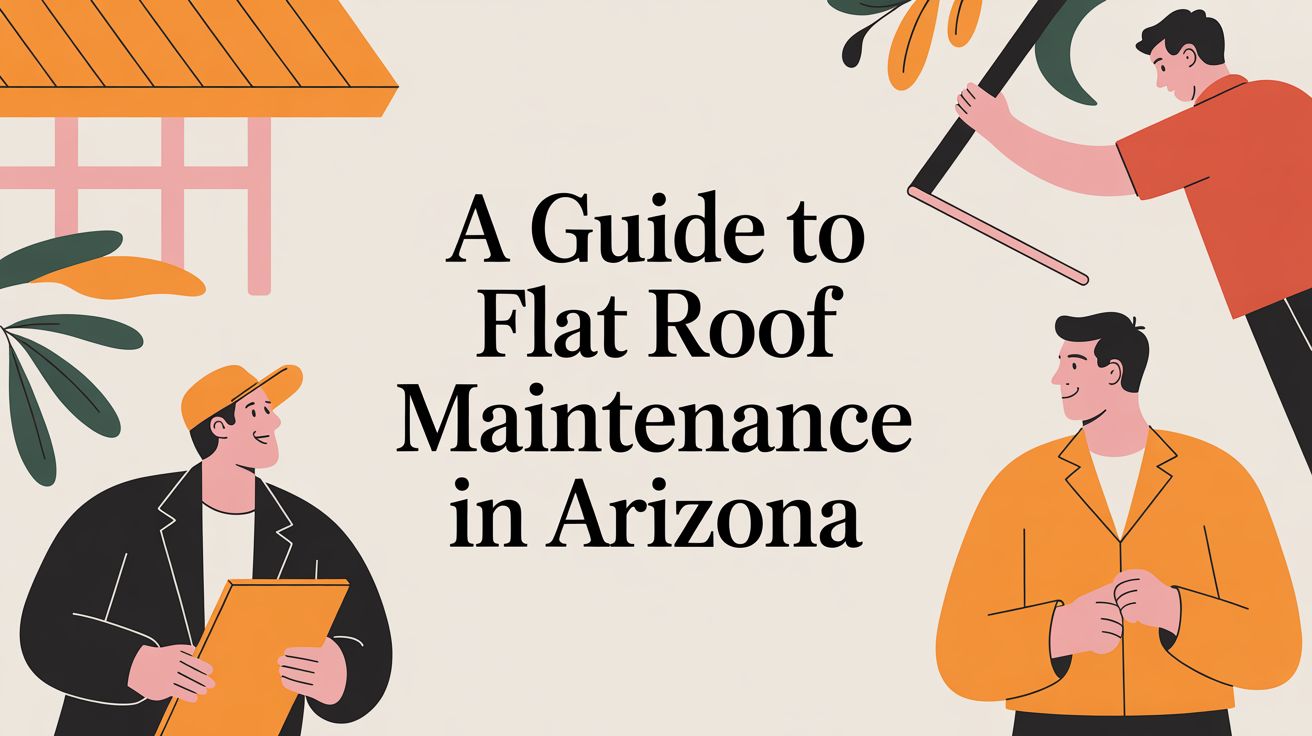
Proper flat roof maintenance is all about routine: regular inspections, keeping debris cleared off, and making small repairs before they become big ones. Out here in the harsh Arizona climate, the sun and monsoon rains are constantly working against your roof. This isn't just busywork—it's what stops tiny cracks and clogged drains from turning into leaks and serious structural damage.
My goal in this guide is to walk you through exactly why our desert climate demands a proactive approach. We’ll cover how to inspect your roof safely, create a seasonal maintenance plan, and tackle minor repairs yourself. By the end, you'll understand how a smart maintenance strategy not only extends the life of your roof but also protects your property as a valuable investment.
Why Arizona Flat Roofs Demand Special Attention
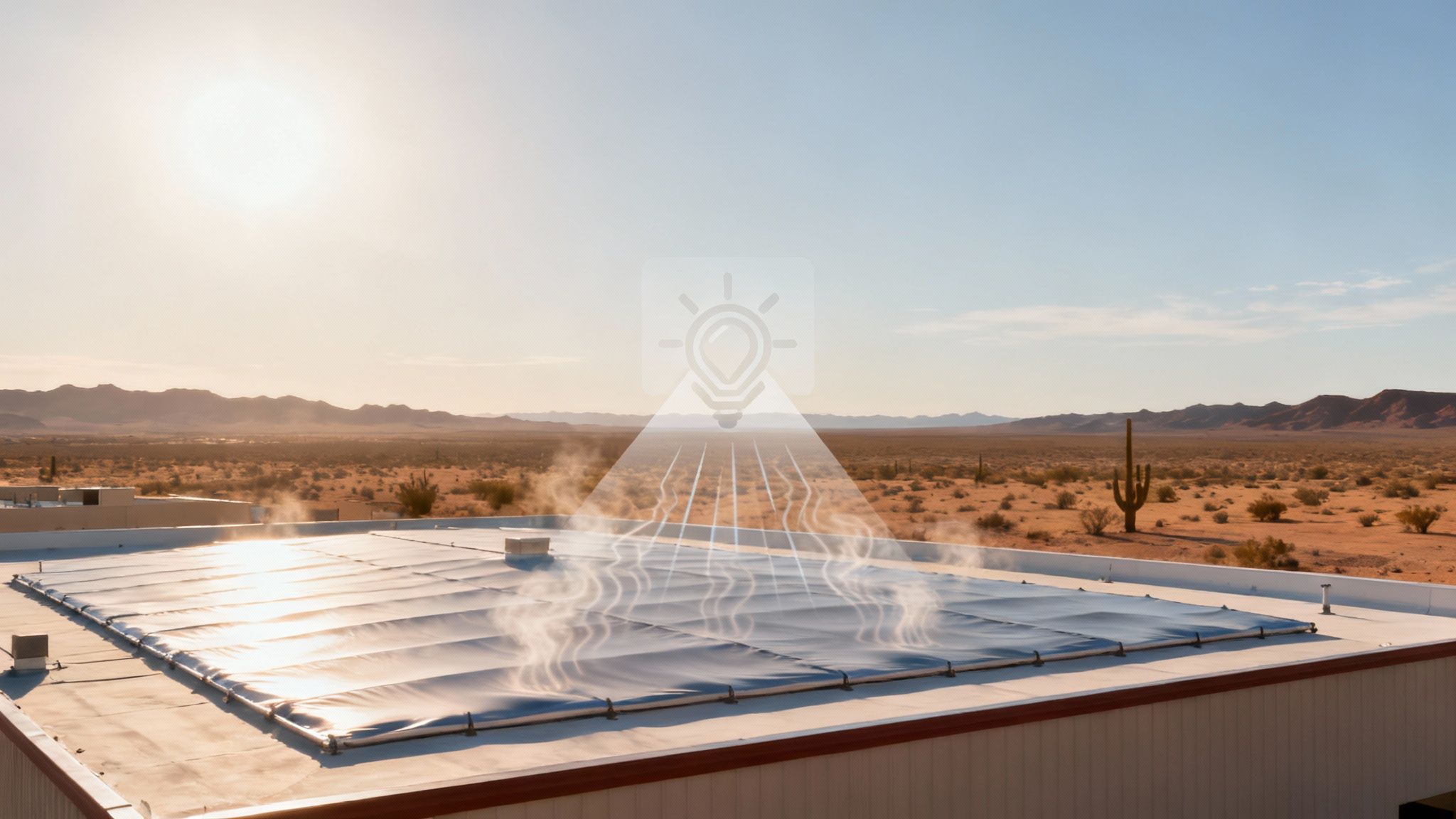
Let’s be direct: taking care of a flat roof in the Arizona desert is a different ballgame. Your roof is your property's first and most critical line of defense, and in Southern Arizona, it’s under constant attack from a unique mix of extreme environmental stress.
This is about more than just patching a leak when you see a drip. Real flat roof maintenance is a strategy I use to protect my clients' assets. It means shifting from a reactive "fix-it-when-it-breaks" mindset to a proactive one where we get ahead of problems before they even start. The goal is to maximize your roof's lifespan, safeguard your building's integrity, and save you from the massive headaches and costs that always come with neglect.
The Unforgiving Desert Climate
Here in Southern Arizona, our roofs face a relentless cycle of challenges that are especially brutal on flat roofing materials. Knowing exactly what you're up against is the first step to doing maintenance right.
Three main factors are always in play:
- Intense UV Radiation: The desert sun is no joke. Day after day, powerful UV rays hammer your roof's surface, breaking down the chemical bonds in the materials. This causes chalking, makes the membrane brittle, and kills its flexibility, leaving it wide open to cracking.
- Extreme Temperature Swings: It's completely normal for the temperature to swing 30 degrees or more from day to night. This forces your roofing materials to constantly expand and contract. Over time, this thermal cycling weakens seams, pulls flashing away from pipes and vents, and creates stress fractures.
- Powerful Monsoon Storms: After months of baking in the sun, the monsoon season hits with torrential rain and high winds. A sun-scorched roof is suddenly hit with a massive amount of water. If your drains are clogged or your membrane is already compromised, you’ve got the perfect recipe for ponding water and disastrous leaks.
A proactive maintenance plan isn't an expense; it's a financial necessity. Neglecting your roof in Arizona doesn't save money—it just defers a much larger, more destructive cost to a later date.
From Minor Issues to Major Disasters
A small crack or a single clogged scupper might not seem like a big deal, but these are the entry points for severe damage. Once water gets through the membrane, it soaks the insulation, seeps into the decking, and eventually leads to rot, mold, and expensive interior damage to your ceilings and walls. You can find more details on why it is important to choose the right team of professionals in Tucson to handle these challenges.
By sticking to a consistent flat roof maintenance schedule, we can catch these little issues early. This preserves the life of your investment and stops a small repair from snowballing into a full-blown crisis.
Calculating the Real Cost of Your Flat Roof
When you're looking at a new roof, it's easy to get fixated on the installation price. But that number is just the first chapter of the story. To really get a handle on the investment, you have to look at the total lifecycle cost—everything from day one until the day it's torn off.
A cheaper roof today can quickly turn into a massive financial headache down the road. This is a huge deal for commercial properties. A failing roof isn't just a repair bill; it's operational downtime, damaged inventory, and lost revenue. A small leak can cause a major business disruption. Smart flat roof maintenance and material choices protect your bottom line for decades.
High-Performance vs. Low-Cost: A Financial Showdown
As you look at options for a new roof installation in Tucson, you’ll face a choice: lower-cost materials or high-performance systems. The price gap might look big at first, but the long-term math tells a completely different story.
Cheaper, single-ply membranes often get cooked by the Arizona sun, leading to a frustrating cycle of repairs and a replacement that comes way too soon. On the other hand, spending more upfront on a durable, hybrid system built for our climate pays for itself. These advanced materials handle the extreme UV and temperature swings far better, meaning less meddling from roofers and a much longer life. It’s a strategic investment that minimizes future costs.
This infographic breaks down how that initial investment, replacement frequency, and ongoing care all play into the total cost of ownership.
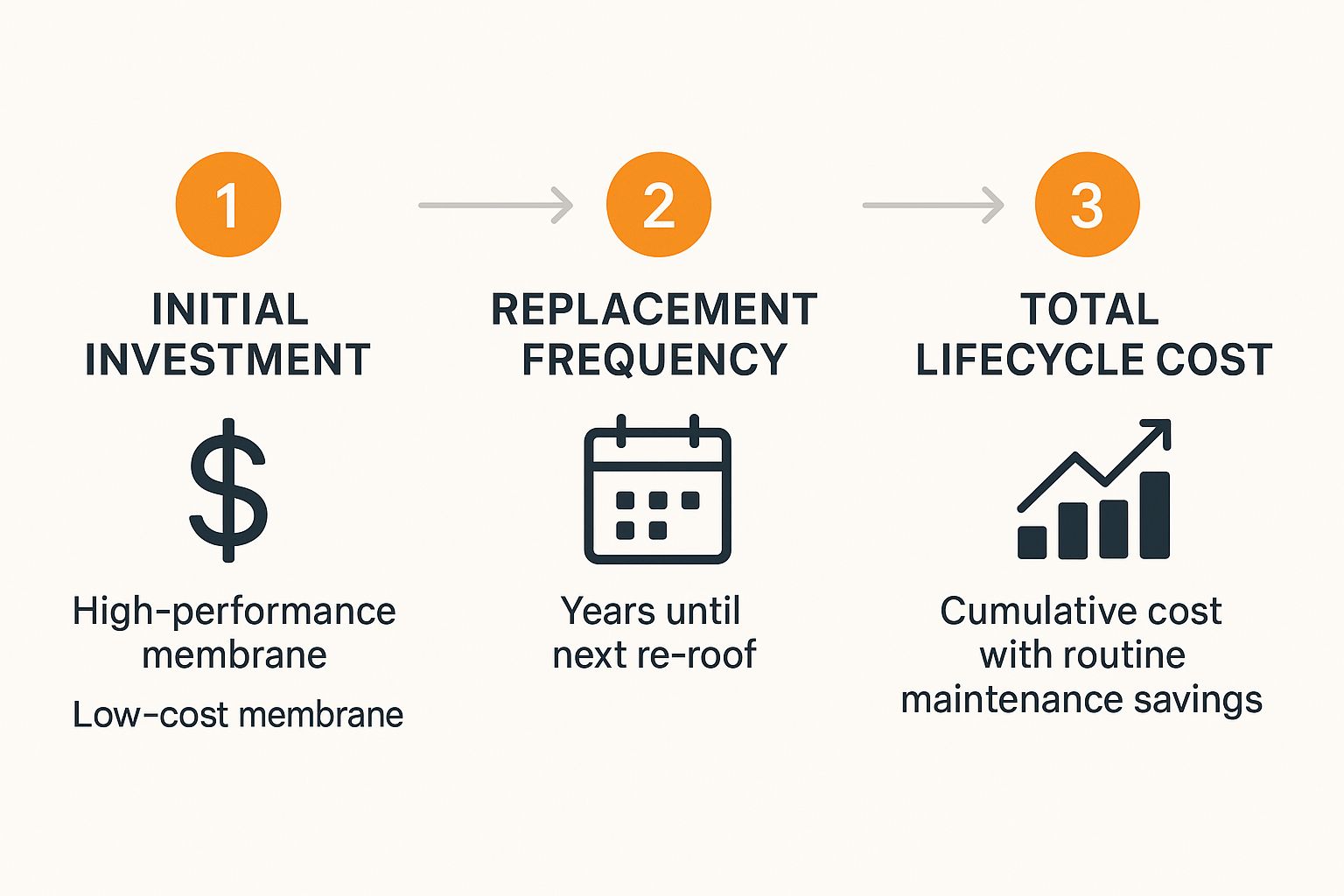
As you can see, the lower initial cost of a standard membrane gets wiped out fast by the need for multiple, expensive replacements over the same timeframe.
The Long-Term Numbers Don't Lie
The financial argument for quality is pretty clear. The initial investment in a high-performance system might be 25–35% higher than a standard membrane. But look at the 20-year picture. A hybrid flat roof system can run about $46,000 (that’s installation with zero replacements). A single-ply membrane needing replacement every 3–4 years? You’re looking at $90,000. The data on various flat roofing materials in 2025 backs this up.
Think of it this way: your flat roof isn't a one-time purchase. It’s an asset that requires a long-term financial strategy. Routine maintenance is the mechanism that protects your initial investment and ensures you get the maximum possible return.
By budgeting for regular check-ups and proactive care, you stop the premature wear and tear that forces those costly replacements. This approach turns your maintenance budget from an "expense" into a high-yield investment. It's the single best way to control long-term costs and make sure your roof lasts as long as it's supposed to.
A Practical Guide to Inspecting Your Flat Roof
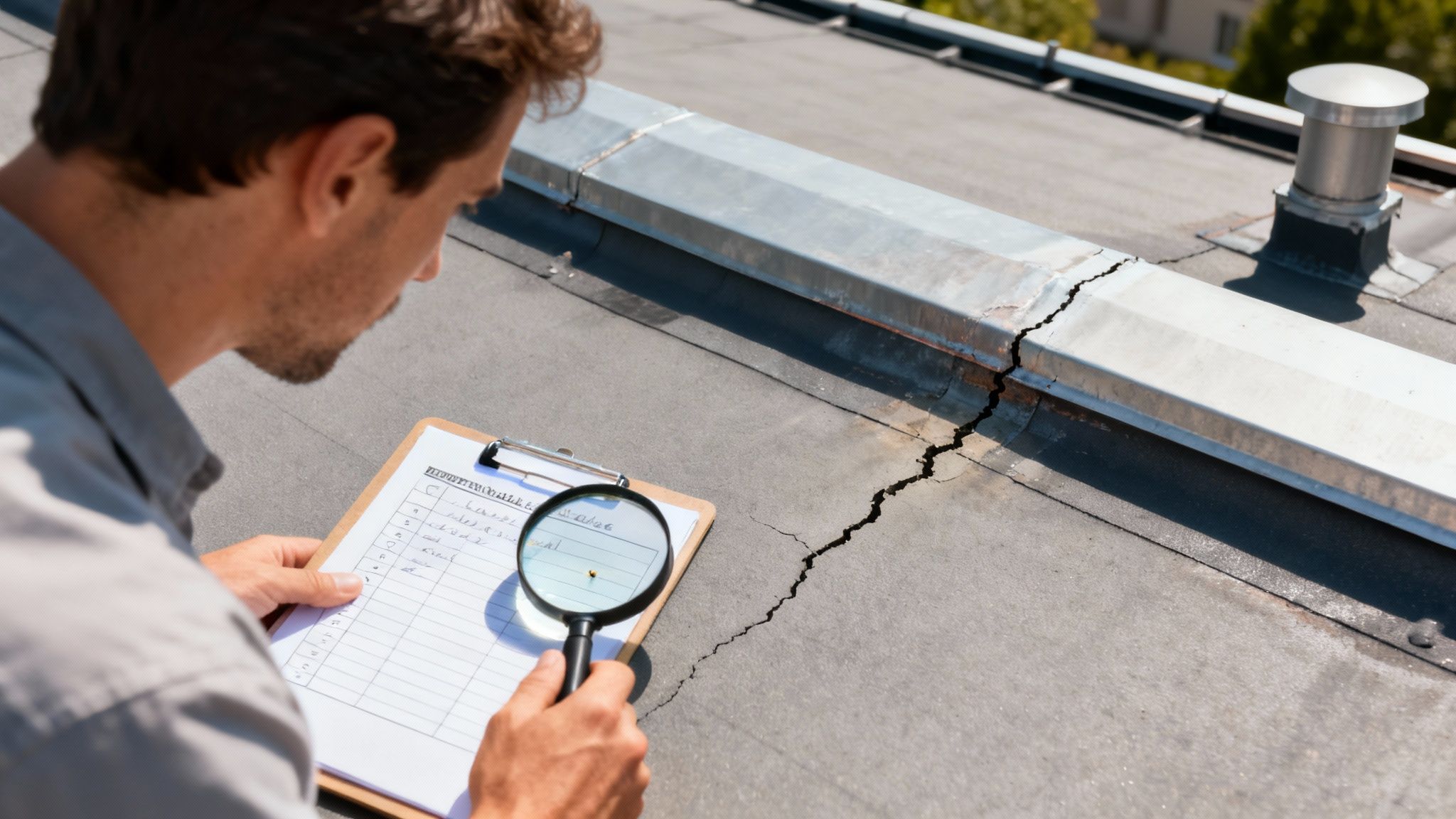
Alright, time to get hands-on. A thorough visual inspection is the absolute cornerstone of flat roof maintenance, and it's something I encourage most property owners to handle themselves. This isn’t about just taking a quick look around; it’s a systematic check-up that helps you catch small problems before they spiral into big, expensive headaches.
The whole key is knowing exactly what to look for and where to focus your attention. Once you get the hang of it, you’ll start to spot the subtle warning signs that the Arizona climate is taking its toll on your roof. Think of this regular walk-through as your best defense against a nasty surprise during monsoon season.
Prioritize Safety Above All Else
Before you even think about stepping onto the roof, let's talk about safety. A fall is no joke, so don't ever take shortcuts or unnecessary risks.
Always follow these ground rules:
- Use a Sturdy Ladder: Make sure your ladder is in good shape and sitting on solid, level ground. It needs to extend at least three feet above the roofline so you have something secure to grab onto.
- Wear the Right Shoes: Grab a pair of shoes with soft, high-traction rubber soles. They’ll protect the roof membrane from scuffs and give you the grip you need.
- Check the Weather: Never get on a roof when it's wet, windy, or during the peak heat of a summer afternoon. A calm, overcast morning is perfect.
- Bring a Buddy: Always have someone on the ground who knows you're up there. They can steady the ladder and be ready to help in an emergency.
Examining the Main Roof Surface
Start your inspection with a wide-angle view. I suggest you walk the entire surface of the main roof field, slowly and deliberately. You’re looking for specific types of damage that are all too common in our desert environment.
The first thing to hunt for is ponding water—that's any puddle that's still hanging around more than 48 hours after it rains. This is a massive red flag. It means you have a drainage issue, and the constant weight and moisture will absolutely destroy roofing materials over time.
Next, scan for these common surface problems:
- Blisters and Bubbles: These are raised spots where air or moisture is trapped under the roof membrane. They're often the first sign that a leak is on its way.
- Cracks and Splits: The intense sun and temperature swings cause these openings, which are direct invitations for water to get into your roofing system.
- Punctures: Look for any holes or tears. These are usually caused by falling tree branches, foot traffic, or even birds pecking at the surface.
- Sun Damage: This is a big one in Arizona. Look for a chalky or dusty film on the surface (I call it chalking) or any spots where the material feels brittle and stiff.
Catching a small blister or a patch of chalking early on is the difference between a simple repair and a much larger, more invasive project. This is the proactive part of flat roof maintenance.
Zeroing In on Vulnerable Areas
While the main surface is important, most flat roof failures happen at the "details"—the spots where something pokes through the roof or where different materials are joined together. These areas demand your closest attention.
Flashing and Penetrations
Flashing is the material that seals the roof around anything that penetrates it, like pipes or vents. This is ground zero for most leaks.
Carefully inspect the seals around:
- Pipes, Vents, and Skylights: Look for gaps, cracks, or old sealant that's pulling away from the fixture.
- HVAC Units: The constant vibration from a heavy AC unit can work the surrounding flashing loose over time. Make sure those seals are still tight.
- Parapet Walls: Check where the flat roof meets the vertical walls. The flashing here should be glued down tight with no signs of peeling or separation.
Seams and Edges
The seams where different rolls of roofing material overlap are another weak point. The adhesive can break down from the constant expansion and contraction. Run your hand carefully along the seams to feel for any loose laps where water could sneak in.
Drainage Systems
Finally, give your drains a once-over. A single clog can turn a light rain into a serious problem.
- Scuppers and Drains: Clear out any leaves, dirt, and debris that could block water from escaping.
- Gutters: Make sure they're clean and securely fastened to the building.
Taking photos of anything you find is a smart move. It helps you track how things are changing from one inspection to the next. If you want an even more detailed guide, our homebuyer roof inspection checklist offers a great framework you can adapt for your own routine. Regular, informed inspections put you in control of your roof's health.
Seasonal Flat Roof Maintenance Checklist for Arizona
Arizona's weather isn't a one-size-fits-all deal; our seasons throw very different challenges at your roof. Sticking to a seasonal maintenance plan helps you stay a step ahead of the damage before it starts.
Here’s a simple checklist I recommend to guide you through the year.
| Season | Key Maintenance Tasks | Why It's Important |
|---|---|---|
| Spring (March-May) | Comprehensive Inspection: Check for winter damage, clear all drains and scuppers of debris. Sealant Check: Inspect all flashing and sealant around penetrations for cracking. | Prepares your roof for the intense summer heat and the coming monsoon season. Catching small cracks now prevents them from becoming major leaks. |
| Summer (June-August) | Post-Monsoon Check: After major storms, look for ponding water, new punctures from debris, and displaced flashing. Surface Temperature: Note any unusually hot spots, which could indicate failing reflective coating. | Monsoon storms are the #1 cause of sudden flat roof failure in Arizona. Immediate checks can prevent small storm damage from causing major interior leaks. |
| Fall (September-November) | Debris Removal: Clear leaves, branches, and dirt that have accumulated over the summer, especially in drainage areas. Coating Assessment: Evaluate the condition of your roof coating after the summer sun. Look for chalking or wear. | Clogged drains in the fall can lead to water backup during winter rains. This is also the ideal time to schedule a recoating before the weather cools. |
| Winter (December-February) | General Inspection: Look for any new damage from temperature fluctuations. Gutter and Drain Check: Ensure drains are clear to handle the gentle but persistent winter rains. | While milder, winter still brings moisture. Freeze-thaw cycles, though rare in Tucson, can worsen existing small cracks in sealant and membranes. |
Following this simple rotation keeps you proactive, not reactive. You'll be addressing seasonal threats head-on, which is the key to getting the maximum lifespan out of your flat roof here in Southern Arizona.
Mastering Essential Cleaning and Minor Repairs
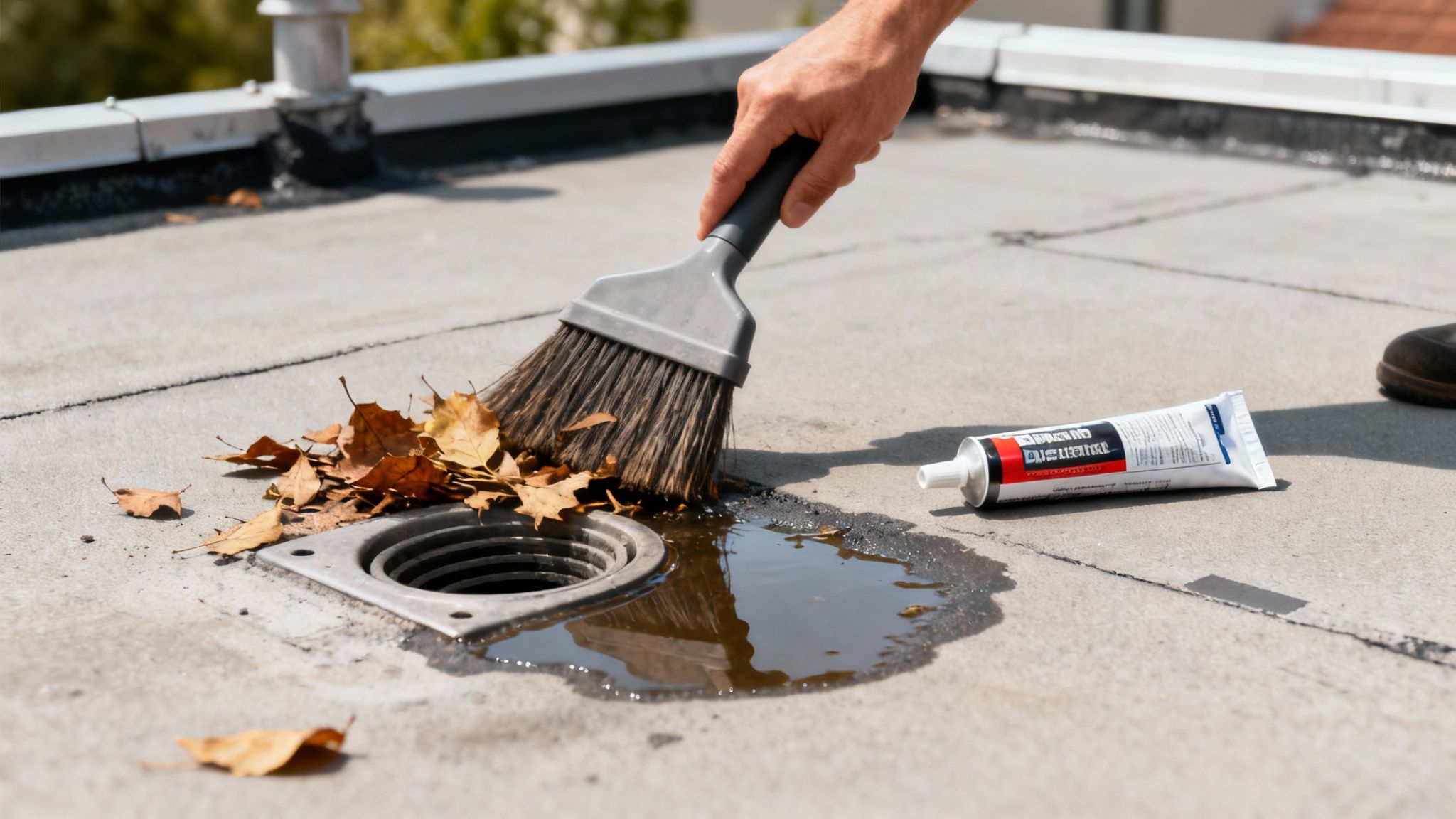
Once your inspection is done, it's time to get to work. The next phase of solid flat roof maintenance is clearing away the dirt and debris that piles up over time, then tackling any small issues you spotted. This isn't just about looks—a clean roof is a high-performing roof, especially when our monsoon season hits.
Think of debris like leaves, dirt, and branches as the building blocks for much bigger problems. They act like sponges, holding moisture against your roof’s surface, and they're the number one reason drains get clogged. A blocked drain is one of the fastest ways to force water where it doesn’t belong, leading to leaks and serious structural strain.
Why Debris Removal is So Critical
Here in Southern Arizona, dust and plant debris are a constant reality. When that gunk is left to sit, it creates a dam that stops water from flowing off your roof the way it was designed to. Honestly, keeping your roof surface clear is probably the single most important DIY task you can do.
For general cleaning, your best tools are simple and safe:
- A soft-bristle broom is perfect for sweeping away loose dirt without gouging the roof membrane.
- A leaf blower can make quick work of clearing large, dry areas.
- A standard garden hose with a low-pressure nozzle can rinse away stubborn grime after you've swept. Never use a pressure washer. The high-pressure stream can easily strip away protective coatings and tear open seams.
Focus your cleaning on the spots where debris loves to collect, like around HVAC units and along the base of parapet walls. A clean surface doesn't just look better; it lets you see the true condition of the membrane underneath.
Ensuring Proper Water Flow
Your roof's drainage system is its most important weapon against our intense monsoon downpours. Scuppers and internal drains have to be completely clear to do their job. Even a small blockage can cause water to back up and create dangerous ponding.
Start by manually pulling out any visible debris from scupper openings and around drain guards. For internal drains, you might need to lift the strainer basket and scoop out the gunk that’s collected inside. After clearing them, run your garden hose to send some water through the system and confirm it’s flowing freely. If it drains slowly or not at all, you've likely got a clog further down the line that requires a professional to snake out.
A clean drain can be the difference between a roof that performs flawlessly during a storm and one that fails catastrophically. Make this a non-negotiable part of your maintenance routine.
Tackling Minor DIY Repairs
During your inspection, you might find small issues you can handle yourself, like a tiny puncture or a cracked seam. Fixing these minor problems right away stops water intrusion before it can cause any real damage.
For small punctures in membranes like TPO or modified bitumen, a professional-grade sealant and patch kit can work wonders. The key is using the right materials for your specific roof. Applying an incompatible sealant can actually react with the roofing material and make the problem much worse. Always check the manufacturer's specs first.
For a minor seam crack:
- Clean the Area: First, thoroughly clean the seam with a recommended cleaning agent to get rid of all dirt, dust, and oils.
- Apply Sealant: Use a caulking gun to apply a steady bead of a compatible, UV-stable sealant directly into the cracked seam.
- Embed Fabric (if needed): For wider cracks, press a strip of reinforcing fabric into the wet sealant, then apply another layer of sealant over the top.
Knowing your limits is just as important as knowing how to do the repair. While handling a small patch is manageable, extensive damage, large blisters, or widespread seam failure is a job for the pros. These are signs that it's time to call in a professional. For more complex issues, exploring your options for expert roof repair in Tucson will ensure the job is done right. Attempting a large-scale repair without proper training can void your roof's warranty and lead to even more expensive problems down the road.
Future-Proofing Your Roof Care Strategy
The roofing world doesn’t stand still, and the way we handle flat roof maintenance needs to keep up. Staying on top of new trends isn't about being flashy; it's about making smarter, more cost-effective decisions that protect your property for the long haul.
A forward-thinking strategy means acknowledging that our climate is changing, the labor market is tightening, and new tech is giving us better ways to work. By understanding these shifts, you can stop just reacting to problems and start getting ahead of them. This is how I make sure my clients' roofs—and their budgets—are ready for whatever comes next.
The New Normal of Extreme Weather
Let's be honest: our weather is getting more intense. The summers feel hotter, and the monsoon storms seem to pack a bigger punch every year. This isn't just a feeling; it's a reality that directly impacts your roof. A maintenance plan that worked a decade ago might not cut it anymore.
This new level of environmental stress makes proactive, preventative care an absolute must. Waiting for a leak to show up is a gamble that gets riskier every year. The data backs this up. Studies have shown that preventive maintenance can slash long-term repair costs by as much as 50% compared to waiting until something breaks. The financial case for proactive care is crystal clear.
Adopting a future-focused maintenance plan means treating your roof like a long-term investment. By anticipating challenges like harsher weather and leveraging new technologies, you protect its value and avoid the costly consequences of falling behind.
The Skilled Labor Challenge
Another major factor is the ongoing skilled labor shortage. Finding experienced, certified, and reliable roofers is getting tougher, which naturally drives up costs. In some areas, industry analysts report these shortages can increase maintenance costs by 15–20%.
This trend makes your relationship with a trusted roofing partner more valuable than ever. Locking in a maintenance agreement with a reputable company doesn't just guarantee regular service; it secures access to a skilled team who knows your roof inside and out. It’s a smart move that helps protect you from price hikes and ensures you have qualified experts on call when you need them.
Technological Advancements in Roof Care
Fortunately, technology is also evolving, giving us powerful new tools to make flat roof maintenance more effective. These aren't sci-fi concepts; they're practical solutions changing how we care for properties right now.
Three key advancements are leading the charge:
- Drone Inspections: Using drones with high-resolution and thermal cameras allows for safer, faster, and far more detailed inspections. A drone can spot hidden moisture trapped under a membrane or identify tiny cracks in hard-to-reach areas—all without a person stepping onto the roof. This reduces risk and improves accuracy.
- Advanced Reflective Coatings: Modern roof coatings are a game-changer, especially here in Arizona. These aren't just thick paint. Advanced formulas contain powerful reflective materials that bounce the sun's harsh UV rays away from your building, significantly lowering the roof's surface temperature.
- Energy Efficiency and Longevity: By keeping the roof cooler, these coatings drastically reduce the thermal stress that causes materials to expand, contract, and break down over time. This not only adds years to your roof's life but also lowers your building's cooling costs. A professional flat roof coating in Tucson can be one of the best investments you make in your property.
Embracing these trends is how you build a robust, future-proof maintenance strategy. It’s all about using every available tool to protect your investment wisely.
How Arizona's Climate Drives Up Maintenance Costs
Budgeting for roof care isn't a simple copy-and-paste job. A maintenance plan that works for a flat roof in a mild, rainy place like Seattle will get you into serious trouble here in Southern Arizona. Our relentless desert climate puts unique pressures on a roof, directly cranking up both the frequency and the cost of keeping it healthy.
The single biggest factor? The sun. That intense, year-round UV exposure is brutal. It aggressively degrades roofing materials, making them brittle and stripping away their protective qualities much faster than in other parts of the country. This means we have to inspect them more often—at least twice a year—and reapply protective coatings far more frequently to shield the membrane underneath. A strategy from a gentler climate would leave a Tucson roof dangerously exposed.
Adjusting Your Budget for the Desert
To build a realistic budget, you have to price in these environmental beatings. For example, a property owner somewhere else might just budget for clearing off leaves and a quick yearly look-over. An Arizona property owner has to factor in the accelerated aging of every single component on that roof.
This means budgeting for more frequent work on:
- Professional Inspections: We’re not just looking for obvious holes. We’re hunting for early signs of sun damage like chalking, blistering, and embrittlement before they become major failures.
- Sealant Reapplication: The seals around vents, pipes, and HVAC units are ground zero for sun damage. They dry out, shrink, and crack incredibly fast under our constant heat.
- Coating Reapplication: Think of reflective coatings as a sacrificial layer. The sun literally eats them away over time, and they must be replenished to keep protecting the roof system.
Ignoring these Arizona-specific needs is a recipe for much higher costs down the road. A tiny crack that might be harmless for months in a mild climate can become a catastrophic leak during one of our powerful monsoon storms. Proactive spending on these climate-specific tasks is just smart money management.
A flat roof maintenance budget in Arizona isn't just about cleaning and inspecting; it's a strategic fund to combat accelerated aging caused by extreme UV radiation and thermal shock.
Cost Per Square Foot: An Arizona Perspective
Nationally, you'll see annual maintenance costs for flat roofs run anywhere from $0.50 to $3.00 per square foot, depending on how complex the roof is. But here's the reality: in extreme heat climates like ours, you're almost always going to land on the higher end of that spectrum. This isn't a choice; it's a necessity driven by the need for robust, heat-resistant systems and more frequent service. For a deeper dive into these global trends, you can explore the research on flat roof markets.
For a typical commercial property in Tucson or Oro Valley, trying to budget at the low end of that national average is just setting yourself up for failure. Planning for costs closer to the $1.50 to $3.00 range gives you a much safer and more accurate financial picture. It ensures you have the resources to actually handle the unique challenges our desert throws at your roof.
Your Flat Roof Maintenance Questions Answered
To wrap things up, I’ve put together a few of the most common questions I get from property owners about flat roof maintenance here in Arizona. My goal is to give you direct answers that clear up any confusion and leave you feeling confident about taking care of your roof.
How Often Should I Get a Professional Inspection?
Given our harsh climate, I always recommend professional inspections twice a year. The first one should happen in the spring to get your roof ready for the brutal summer heat and monsoons. The second should be in the fall to check for any damage the summer storms left behind.
Sticking to this schedule is the single best way to catch small issues before they spiral into expensive, messy emergencies.
Can I Use a Pressure Washer on My Flat Roof?
I strongly advise against it. It’s one of the fastest ways to cause serious damage. High-pressure water can easily tear the roof membrane, blast away protective coatings, and force water into seams where it doesn't belong.
You’re much better off using a soft-bristle broom and a standard garden hose. It's just as effective for cleaning off dirt and won't risk damaging your roof.
Ponding water is any water that sits on your roof for more than 48 hours after it rains. It's a major red flag because that constant moisture breaks down roofing materials and adds a ton of weight to your building's structure.
What is Ponding Water and Why Is It Bad?
If you see ponding water, it's a clear sign of a bigger problem—usually poor drainage or even structural settling that needs immediate attention.
Worse yet, that stagnant water is the perfect breeding ground for vegetation. Once roots start growing, they can puncture the roof membrane, creating a direct path for leaks right into your property.
If you're ready to protect your investment with a professional maintenance plan, the team at Sunrise Roofers LLC is here to help. Get in touch with us for an honest, thorough inspection and a clear plan to keep your roof in top shape. Schedule your free, no-obligation roof evaluation today!
Need roofing services in Tucson? Request a free inspection or call 520-668-6638. Related pages: Roof Repair · Roof Replacement · Service Areas.
Published by Sunrise Roofers LLC
Licensed & Insured Roofing Contractor · Tucson, AZ